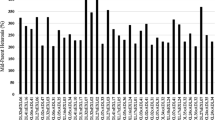Abstract
Breeding maize hybrids for drought tolerance would significantly reduce yield loss due to drought in southern Africa. Mode of gene action controlling yield and secondary traits was investigated by mating 27 inbred lines, in sets according to a North Carolina design II scheme. The resultant 72 experimental and eight commercial hybrids were evaluated in 8 × 10 α-lattice design with two replications, in four drought and two non-drought environments. Under drought conditions, only general combining ability (GCA) variance was significant for yield, indicating predominance of additive effects. In non-drought environments, both GCA and specific combining ability variances were significant for yield, indicating importance of additive and non-additive effects, respectively. Contributions of male (GCAm) and female GCA (GCAf) effects to hybrids varied depending on the trait and conditions. Superior GCAf to GCAm effects for yield under drought conditions, and for ASI, prolificacy and ear aspect under both drought and non-drought conditions, suggested that maternal effects might have modified these traits. Larger GCAm than GCAf for ASI and silking dates under normal conditions indicated that paternal genotypes played a greater role in determining these traits. Similar GCAm and GCAf for yield under normal conditions, silking and anthesis dates under drought indicated that both parents made similar contribution to hybrids. Possibly, complications due to modification of traits by cytoplasmic effects and cross-over G × E for yield might partly explain why only a few drought tolerant hybrids have been developed. Practical implications of these findings in breeding drought tolerance in maize are discussed.
Similar content being viewed by others
References
Agrama HAS, Moussa ME (1996) Map** QTLs in breeding for drought tolerance in maize (Zea mays L.). Euphytica 91:89–97
Banziger M, Diallo AO (2001) Stress tolerant maize for farmers in sub-Saharan Africa. In: CIMMYT Maize Research Highlights 1999–2000. CIMMYT, Mexico. D.F., pp 1–8
Banziger M, Edmeades GO, Beck D, Bellon M (2000) Breeding for drought and nitrogen stress tolerance in maize: from theory to practice. CIMMYT, Mexico, D.F
Betran FJ, Beck D, Banziger M, Edmeades GO (2003a) Genetic analysis of inbred and hybrid grain yield under stress and non-stress environments in tropical maize. Crop Sci 43:807–817
Betran FJ, Beck D, Banziger M, Edmeades GO (2003b) Secondary traits in parental inbreds and hybrids under stress and non-stress environments in tropical maize. Field Crops Res 83:51–65
Bhat BK, Dhawan NL (1971) The role of cytoplasm in the manifestation of quantitative characters of maize. Genetica 42:165–174
Bolanos J, Edmeades GO (1996) The importance of the anthesis-silking interval in breeding for drought tolerance in tropical maize. Field Crops Res 48:65–80
Cakir R (2004) Effect of water stress at different development stages on vegetative and reproductive growth of corn. Field Crops Res 89:1–6
Campos H, Cooper M, Habben JE, Edmeades GO, Schussler JR (2004) Improving drought tolerance in maize: a view from industry. Field Crops Res 90:19–34
Campos H, Cooper M, Edmeades GO, Loffer C, Schussler JR, Ibanez M (2006) Changes in drought tolerance in maize associated with fifty years of breeding for yield in the US corn-belt. Maydica 51:369–381
Chapman SC, Edmeades GO (1999) Selection improves drought tolerance in tropical maize populations: II. Direct and correlated responses among secondary traits. Crop Sci 39:1315–1324
Edmeades GO, Bolanos J, Chapman SC, Lafitte HR, Banziger M (1999) selection improves drought tolerance in tropical maize populations: I. gains in biomass, grain yield, and harvest index. Crop Sci 11:1306–1315
Gevers HO, Whythe IV (1987) Patterns of heterosis in South African maize breeding material. In: Fourie AP, Duplessis JG (eds) Proc 7th South Afri Maize Breed Sympo 1986, Summer Grain Centre, Grain Crops Res Inst, pp 21–26
Hallauer AR (1990) Methods used in develo** maize inbreds. Maydica 35:1–16
Hallauer AR, Miranda JB (1988) Quantitative genetics in maize breeding, 2nd edn. Iowa State University Press, Ames
Kang MS (1994) Applied quantitative genetics. Kang, M.S. Publisher, Baton Rouge, LA, USA
Kearsey MJ, Pooni HS (1996) The genetical analysis of quantitative traits. Chapman and Hall, London
Khehra AS, Bhalla SK (1976) Cytoplasmic effects on quantitative characters in maize (Zea mays L.). Theor Appl Genet 47:271–274
Lamkey KR, Schnicker BJ, Gocken TL (1993) Choice of source populatins for inbred line improvement. Proc 48th Annual Corn & Sorghum Conf, pp 91–103
Mickelson HR, Cordova H, Pixley KV, Bjarnason MS (2001) Heterotic relationships among nine temperate and subtropical maize populations. Crop Sci 41:1012–1020
Moreno A, Lumbreras V, Pages M (2005) Drought tolerance in maize. Maydica 50:549–558
Richardson CJ (2005) The loss of property rights and the collapse of Zimbabwe. The Cato J 25(2):25
Rosen S, Scott L (1992) Famine grips sub-Saharan Africa. Agricultural Outlook 191:20–24
Rosielle AA, Hamblin J (1981) Theoretical aspects of selection for yield in stress and non-stress environments. Crop Sci 21:943–946
Tuberosa R, Frascaroli E, Salvi S, Sangauineti MC, Conti S, Landi P (2005) QTLs for tolerance to abiotic stresses in maize: present status and prospects. Maydica 50:559–569
Vasal SK, Srinivasan G, Cordova H, Pandey S, Jeffers D, Bergvinson D, Beck D (1999) Inbred line evaluation nurseries and their role in maize breeding at CIMMYT. Maydica 44:341–351
Zaidi PH, Srinivasan G, Cordova HS, Sanchez C (2004) Gains from improvement for mid season drought tolerance in tropical maize (Zea mays L.) Field Crops Res 89:135–152
Acknowledgements
We thank The Rockefeller Foundation for financial support. We also thank CIMMYT and Seed Co Ltd (Zimbabwe) for providing the germplasm. The authors are also grateful for use of research facilities and thank all the supporting staff at Save Valley Experiment Station (Govt of Zimbabwe), Kadoma Research Centre (Seed Co Ltd) and CIMMYT, in Zimbabwe.
Author information
Authors and Affiliations
Corresponding author
Rights and permissions
About this article
Cite this article
Derera, J., Tongoona, P., Vivek, B.S. et al. Gene action controlling grain yield and secondary traits in southern African maize hybrids under drought and non-drought environments. Euphytica 162, 411–422 (2008). https://doi.org/10.1007/s10681-007-9582-4
Received:
Accepted:
Published:
Issue Date:
DOI: https://doi.org/10.1007/s10681-007-9582-4




